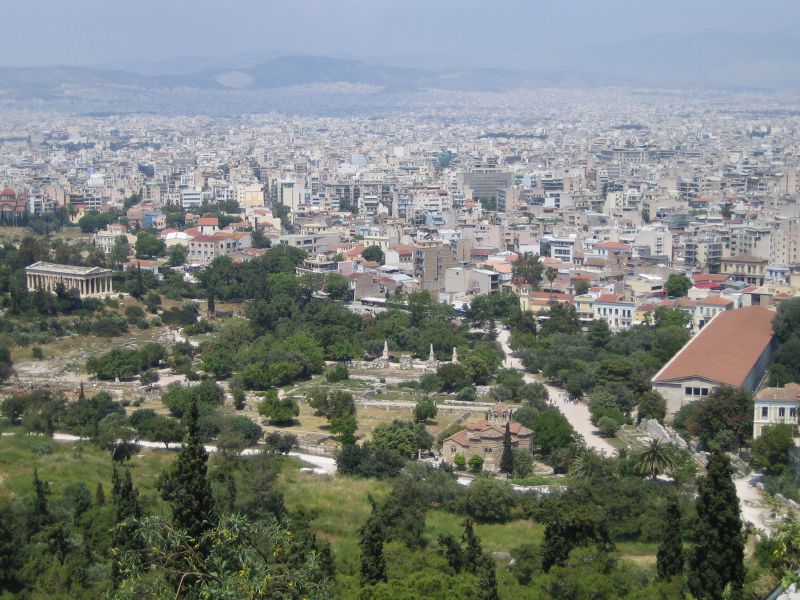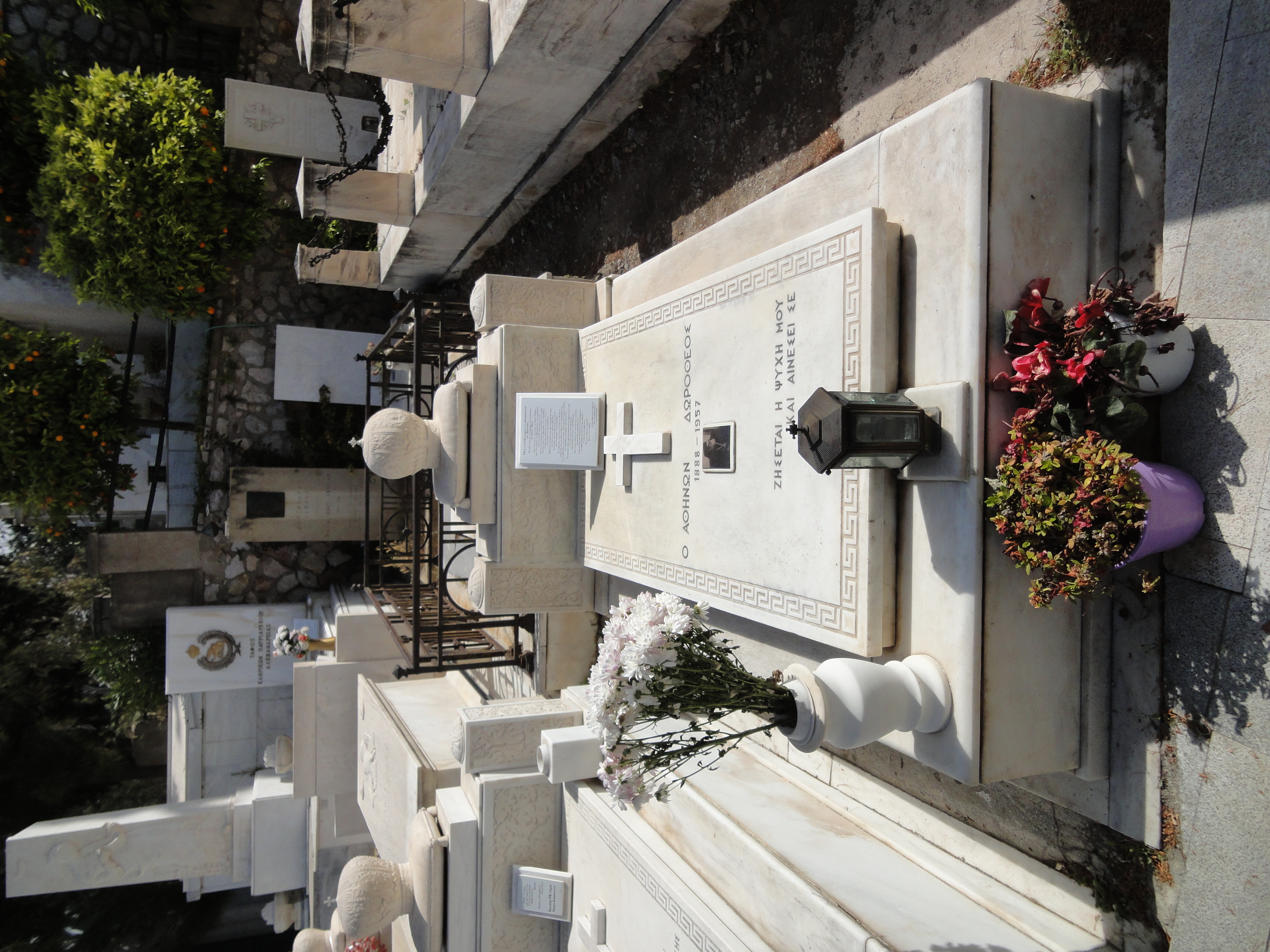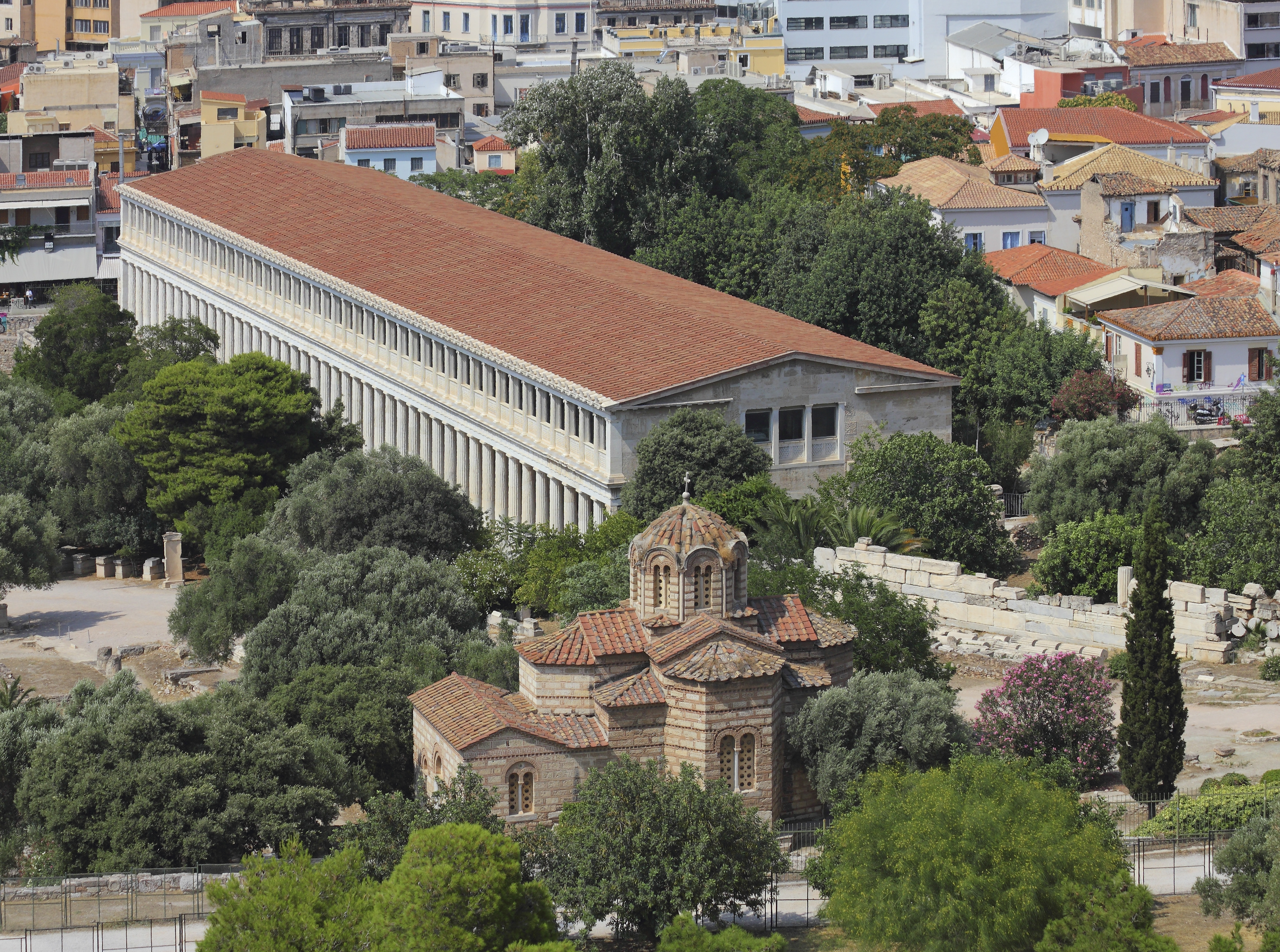|
Stoa Of Attalus
The Stoa of Attalos (also spelled Attalus) was a stoa (covered walkway or portico) in the Agora of Athens, Greece. It was built by and named after King Attalos II of Pergamon, who ruled between 159 BC and 138 BC. The current building was reconstructed from 1952 to 1956 by the American School of Classical Studies at Athens and currently houses the Museum of the Ancient Agora. Description Typical of the Hellenistic age, the stoa was more elaborate and larger than the earlier buildings of ancient Athens and had two rather than the normal one storeys. The stoa's dimensions are and it is made of Pentelic marble and limestone. The building skillfully makes use of different architectural orders. The Doric order was used for the exterior colonnade on the ground floor with Ionic for the interior colonnade. This combination had been used in stoas since the Classical period and was by Hellenistic times quite common. On the first floor of the building, the exterior colonnade was Ionic a ... [...More Info...] [...Related Items...] OR: [Wikipedia] [Google] [Baidu] |
Ancient Agora Of Athens
The ancient Agora of Athens (also called the Classical Agora) is the best-known example of an ancient Greek agora, located to the northwest of the Acropolis and bounded on the south by the hill of the Areopagus and on the west by the hill known as the Agoraios Kolonos, also called Market Hill. The Agora's initial use was for a commercial, assembly, or residential gathering place. Buildings and structures of the classical agora North side of the agora * Stoa Poikile (Painted stoa), a building built in the 4th century B.C. used purely for socialising unlike many other buildings in the agora. * Altar of the Twelve Gods * Stoa Basileios (Royal stoa) * Temple of Aphrodite Urania *The south end of what is believed to be a Basilica has been uncovered near Hadrian Street and is dated to the mid 100s CE East side of the agora * The Stoa of Attalos, a stoa lined with shops built in the 2nd century B.C. which has since been reconstructed for use as the Museum of The Ancient Agora. * ... [...More Info...] [...Related Items...] OR: [Wikipedia] [Google] [Baidu] |
Carneades
Carneades (; el, Καρνεάδης, ''Karneadēs'', "of Carnea"; 214/3–129/8 BC) was a Greek philosopher and perhaps the most prominent head of the Skeptical Academy in ancient Greece. He was born in Cyrene. By the year 159 BC, he had begun to attack many previous dogmatic doctrines, especially Stoicism and even the Epicureans whom previous skeptics had spared . As scholarch (leader) of the Academy, he was one of three philosophers sent to Rome in 155 BC where his lectures on the uncertainty of justice caused consternation among leading politicians. He left no writings. Many of his opinions are known only via his successor Clitomachus. He seems to have doubted the ability not just of the senses but of reason too in acquiring truth. His skepticism was, however, moderated by the belief that we can, nevertheless, ascertain probabilities (not in the sense of statistical probability, but in the sense of persuasiveness) of truth, to enable us to act. Biography Carneades, the so ... [...More Info...] [...Related Items...] OR: [Wikipedia] [Google] [Baidu] |
Lithuania
Lithuania (; lt, Lietuva ), officially the Republic of Lithuania ( lt, Lietuvos Respublika, links=no ), is a country in the Baltic region of Europe. It is one of three Baltic states and lies on the eastern shore of the Baltic Sea. Lithuania shares land borders with Latvia to the north, Belarus to the east and south, Poland to the south, and Russia to the southwest. It has a Maritime boundary, maritime border with Sweden to the west on the Baltic Sea. Lithuania covers an area of , with a population of 2.8 million. Its capital and largest city is Vilnius; other major cities are Kaunas and Klaipėda. Lithuanians belong to the ethno-linguistic group of the Balts and speak Lithuanian language, Lithuanian, one of only a few living Baltic languages. For millennia the southeastern shores of the Baltic Sea were inhabited by various Balts, Baltic tribes. In the 1230s, Lithuanian lands were united by Mindaugas, Monarchy of Lithuania, becoming king and founding the Kingdom of Lithuania ... [...More Info...] [...Related Items...] OR: [Wikipedia] [Google] [Baidu] |
Latvia
Latvia ( or ; lv, Latvija ; ltg, Latveja; liv, Leţmō), officially the Republic of Latvia ( lv, Latvijas Republika, links=no, ltg, Latvejas Republika, links=no, liv, Leţmō Vabāmō, links=no), is a country in the Baltic region of Northern Europe. It is one of the Baltic states; and is bordered by Estonia to the north, Lithuania to the south, Russia to the east, Belarus to the southeast, and shares a maritime border with Sweden to the west. Latvia covers an area of , with a population of 1.9 million. The country has a temperate seasonal climate. Its capital and largest city is Riga. Latvians belong to the ethno-linguistic group of the Balts; and speak Latvian, one of the only two surviving Baltic languages. Russians are the most prominent minority in the country, at almost a quarter of the population. After centuries of Teutonic, Swedish, Polish-Lithuanian and Russian rule, which was mainly executed by the local Baltic German aristocracy, the independent R ... [...More Info...] [...Related Items...] OR: [Wikipedia] [Google] [Baidu] |
Estonia
Estonia, formally the Republic of Estonia, is a country by the Baltic Sea in Northern Europe. It is bordered to the north by the Gulf of Finland across from Finland, to the west by the sea across from Sweden, to the south by Latvia, and to the east by Lake Peipus and Russia. The territory of Estonia consists of the mainland, the larger islands of Saaremaa and Hiiumaa, and over 2,200 other islands and islets on the eastern coast of the Baltic Sea, covering a total area of . The capital city Tallinn and Tartu are the two largest urban areas of the country. The Estonian language is the autochthonous and the official language of Estonia; it is the first language of the majority of its population, as well as the world's second most spoken Finnic language. The land of what is now modern Estonia has been inhabited by '' Homo sapiens'' since at least 9,000 BC. The medieval indigenous population of Estonia was one of the last " pagan" civilisations in Europe to adopt Ch ... [...More Info...] [...Related Items...] OR: [Wikipedia] [Google] [Baidu] |
Czech Republic
The Czech Republic, or simply Czechia, is a landlocked country in Central Europe. Historically known as Bohemia, it is bordered by Austria to the south, Germany to the west, Poland to the northeast, and Slovakia to the southeast. The Czech Republic has a hilly landscape that covers an area of with a mostly temperate continental and oceanic climate. The capital and largest city is Prague; other major cities and urban areas include Brno, Ostrava, Plzeň and Liberec. The Duchy of Bohemia was founded in the late 9th century under Great Moravia. It was formally recognized as an Imperial State of the Holy Roman Empire in 1002 and became a kingdom in 1198. Following the Battle of Mohács in 1526, the whole Crown of Bohemia was gradually integrated into the Habsburg monarchy. The Protestant Bohemian Revolt led to the Thirty Years' War. After the Battle of White Mountain, the Habsburgs consolidated their rule. With the dissolution of the Holy Empire in 1806, the Cro ... [...More Info...] [...Related Items...] OR: [Wikipedia] [Google] [Baidu] |
Cyprus
Cyprus ; tr, Kıbrıs (), officially the Republic of Cyprus,, , lit: Republic of Cyprus is an island country located south of the Anatolian Peninsula in the eastern Mediterranean Sea. Its continental position is disputed; while it is geographically in Western Asia, its cultural ties and geopolitics are overwhelmingly Southern European. Cyprus is the third-largest and third-most populous island in the Mediterranean. It is located north of Egypt, east of Greece, south of Turkey, and west of Lebanon and Syria. Its capital and largest city is Nicosia. The northeast portion of the island is ''de facto'' governed by the self-declared Turkish Republic of Northern Cyprus, which was established after the 1974 invasion and which is recognised as a country only by Turkey. The earliest known human activity on the island dates to around the 10th millennium BC. Archaeological remains include the well-preserved ruins from the Hellenistic period such as Salamis and Kourion, and Cypr ... [...More Info...] [...Related Items...] OR: [Wikipedia] [Google] [Baidu] |
Treaty Of Accession 2003
The Treaty of Accession 2003 was the agreement between the member states of the European Union and ten countries (Czech Republic, Estonia, Cyprus, Latvia, Lithuania, Hungary, Malta, Poland, Slovenia, Slovakia), concerning these countries' accession into the EU (see 2004 enlargement of the European Union). At the same time it changed a number of points which were originally laid down in the Treaty of Nice. The treaty was signed on 16 April 2003 in Athens, Greece and it entered into force on 1 May 2004, resulting in enlargement of the European Union with 10 states. Background The European Union comprises a large number of overlapping legal structures which is a result of it being defined by successive international treaties. As well as other acts which together form the current legal framework (acquis) of the EU, the Treaty of Accession 2003 modifies: *the Treaty of Rome (establishing the European Economic Community), *the Euratom Treaty (establishing the European Atomic En ... [...More Info...] [...Related Items...] OR: [Wikipedia] [Google] [Baidu] |
Dorotheus Of Athens
Dorotheus ( el, Δωρόθεος, secular name Ioannis Kottaras el, Ιωάννης Κοτταράς) was Archbishop of Athens and All Greece from 1956 to 1957. He was born in Hydra in 1888 and studied theology at the University of Athens, from where he graduated in 1909. He then studied law at the Universities of Athens and Leipzig, and specialised in ecclesiastical law. For a brief period, he was a schoolteacher in Sparta. He became a monk, and was ordained a deacon on 18 September 1910 by the then Metropolitan Bishop of Hydra and Spetses Ioasaph and served as a deacon for nine years in the Church of St George Carytses in Athens. On 18 December 1922 he was ordained a priest by the then Metropolitan Bishop of Hydra and Spetses Procopius. Two days later, he was ordained a bishop by the then Metropolitan Bishops of Fthiotida Ambrosius and Syros Athanasius, and was appointed Metropolitan Bishop of Kythera and Antikythera. On 15 January 1935 he was transferred to the Metropolis of ... [...More Info...] [...Related Items...] OR: [Wikipedia] [Google] [Baidu] |
Mount Pentelicus
Mount Pentelicus or Pentelikon (, or ) is a mountain in Attica, Greece, situated northeast of Athens and southwest of Marathon. Its highest point is the peak ''Pyrgari'', with an elevation of 1,109 m. The mountain is covered in large part with forest (about 60 or 70%), and can be seen from southern Athens (Attica), the Pedia plain, Parnitha, and the southern part of the northern suburbs of Athens. Houses surround the mountain, especially in Vrilissia, Penteli, Ekali, Dionysos and north of Gerakas. Marble from Mount Pentelicus is of exceptionally high quality and was used to construct much of the Athenian Acropolis. Later, Pentelic marble was exported to Rome, where it was used in construction and in sculptures. In ancient times it was also called Brilissos or Brilittos (, ) which is the origin of the name of the nearby suburb of Vrilissia. Mountain Mount Pentelicus has been famous for its marble since antiquity. Pentelic marble was used for the construction of buildings in ... [...More Info...] [...Related Items...] OR: [Wikipedia] [Google] [Baidu] |
John D
John is a common English name and surname: * John (given name) * John (surname) John may also refer to: New Testament Works * Gospel of John, a title often shortened to John * First Epistle of John, often shortened to 1 John * Second Epistle of John, often shortened to 2 John * Third Epistle of John, often shortened to 3 John People * John the Baptist (died c. AD 30), regarded as a prophet and the forerunner of Jesus Christ * John the Apostle (lived c. AD 30), one of the twelve apostles of Jesus * John the Evangelist, assigned author of the Fourth Gospel, once identified with the Apostle * John of Patmos, also known as John the Divine or John the Revelator, the author of the Book of Revelation, once identified with the Apostle * John the Presbyter, a figure either identified with or distinguished from the Apostle, the Evangelist and John of Patmos Other people with the given name Religious figures * John, father of Andrew the Apostle and Saint Peter * Pope Jo ... [...More Info...] [...Related Items...] OR: [Wikipedia] [Google] [Baidu] |
American School Of Classical Studies At Athens
, native_name_lang = Greek , image = American School of Classical Studies at Athens.jpg , image_size = , image_alt = , caption = The ASCSA main building as seen from Mount Lykavittos , latin_name = , other_name = , former_name = , motto = , motto_lang = , mottoeng = , established = 1881 , closed = , type = Overseas Research Center / Higher Education , parent = , affiliation = , religious_affiliation = , academic_affiliation = , endowment = , budget = , officer_in_charge = , chairman = , chairperson = , chancellor = , president = , vice-president = , superintendent = , provost = , vice_chancellor = , rector = , principal = , dean = , director = , head_label = , head = , academic_staff = , administrative_staff = , students = , undergrad = , postgrad = , doctoral = , other = , city = Athens , state = , province = , country = Greece , coor = , campus = urban , language = , free_label = , fr ... [...More Info...] [...Related Items...] OR: [Wikipedia] [Google] [Baidu] |



